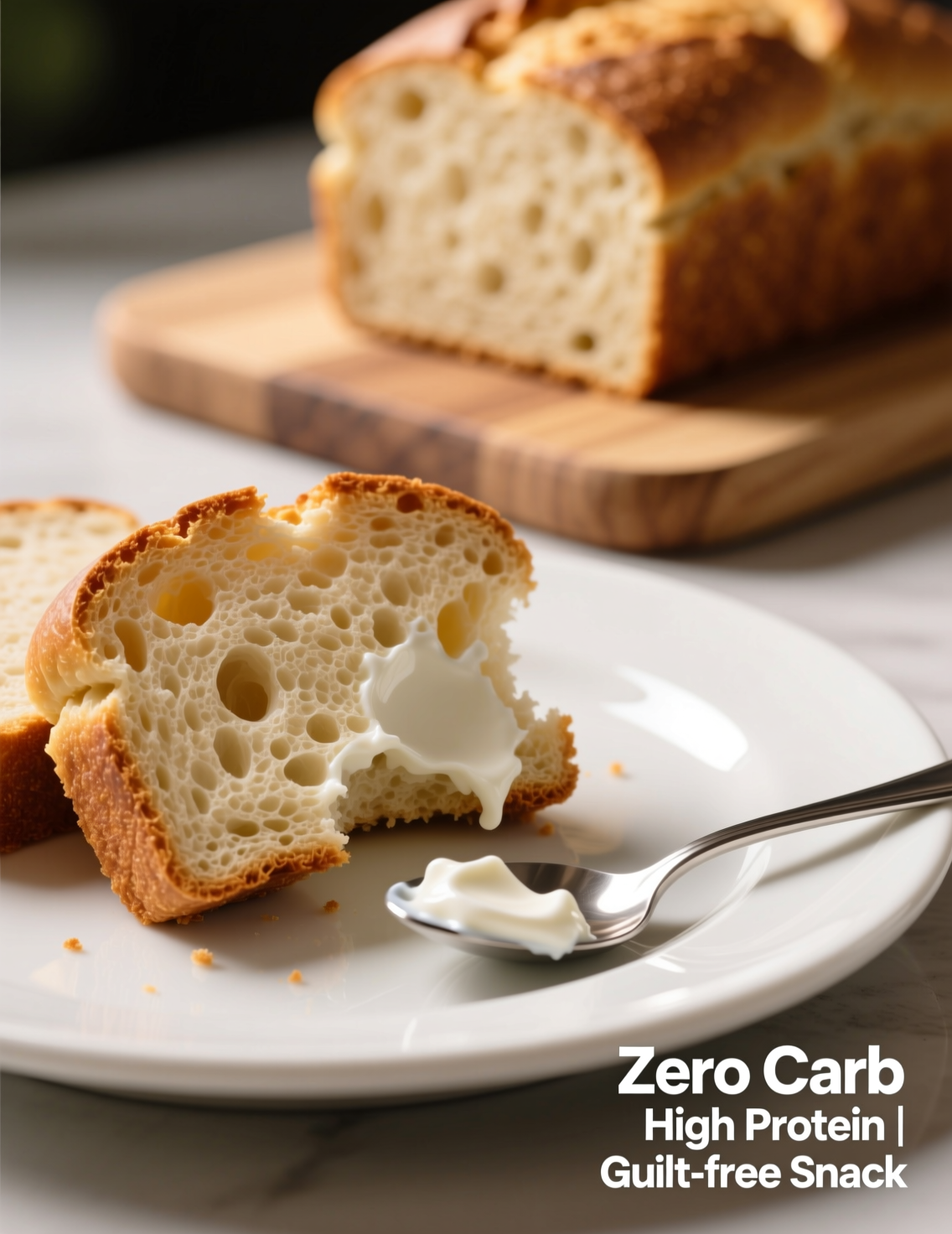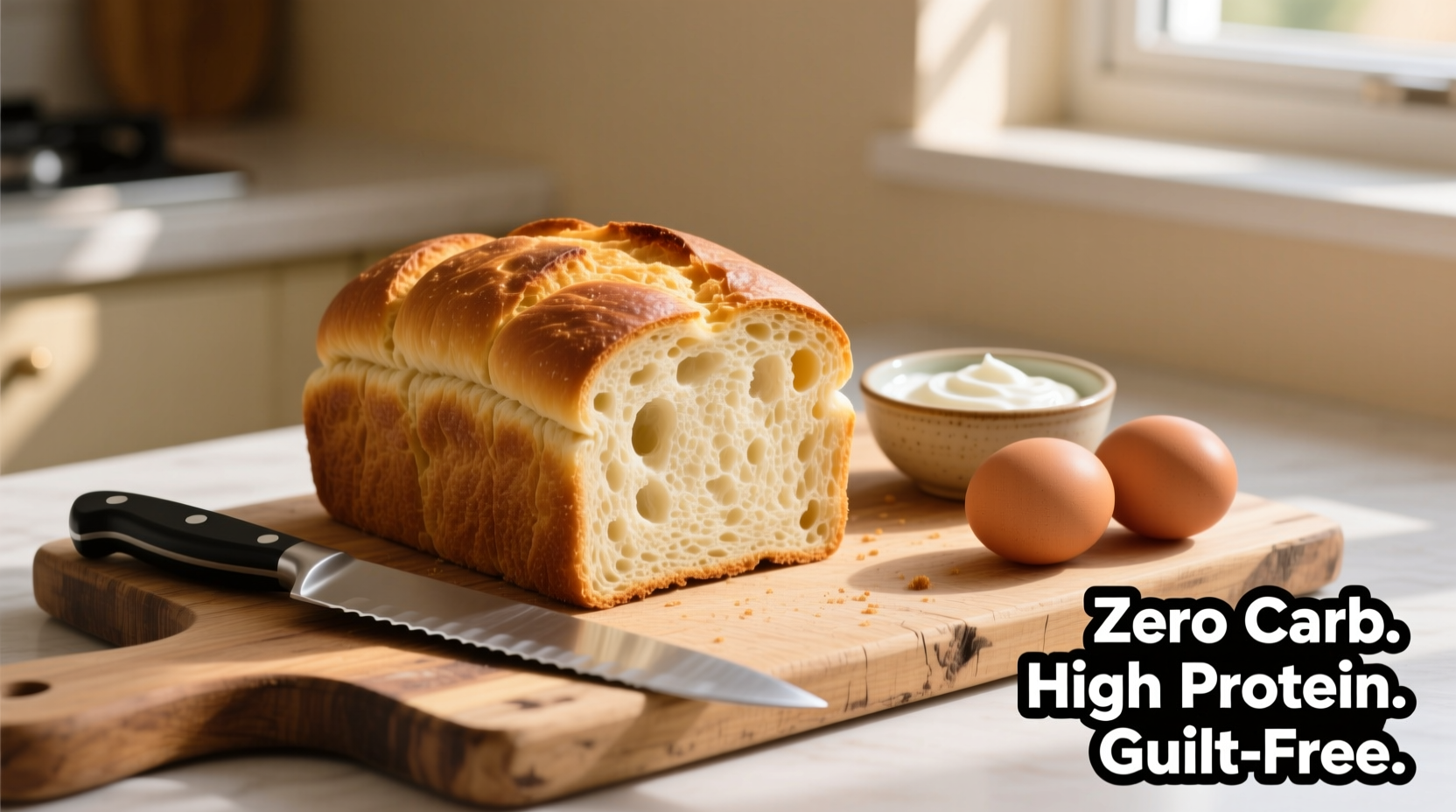There’s something quietly magical about baking bread that doesn’t make your blood sugar jump. A loaf that rises with pride but leaves carbs behind. That’s where this Easy Zero Carb Yogurt Bread with Greek Yogurt and Eggs Recipe comes in—simple, reliable, and downright delicious.
Now, I’ve tested dozens of “low-carb breads” that promised fluff and flavor. Most turned out either spongy like old gym towels or dense as bricks. But this one? It’s the real deal. It’s high in protein, totally grain-free, and bakes up tender, not rubbery. Perfect for toast, sandwiches, or just plain warm with butter melting into its crumb.
Let’s dive into the how, the why, and a few expert tricks that make this humble loaf shine.
What Makes This Bread Truly Zero Carb
First things first. Bread and zero carbs rarely belong in the same sentence. But when you replace the usual flour with ingredients like Greek yogurt and eggs, you’re changing the entire nutritional profile.
Greek yogurt brings body, moisture, and a mild tang—similar to sourdough’s edge but without fermentation. Eggs act as both binder and leavening support. No almond flour, no coconut flour—none of the typical suspects. That’s why this recipe is called true zero-carb bread.
Per slice (depending on size), it holds nearly 0g net carbs, about 6–8g protein, and is rich in calcium. It’s keto-friendly, diabetic-friendly, and excellent for anyone watching macros tightly.
The Science Behind the Texture
Ever wonder why low-carb breads can taste so eggy or feel like chewing on memory foam? It’s all about protein structure and air incorporation.
Egg proteins coagulate when heated, giving structure. Greek yogurt adds casein, another protein that softens and stabilizes that matrix. When whisked together properly, the mixture traps tiny air pockets. Bake it right, and those air bubbles expand, creating a light, tender crumb.
It’s a little kitchen chemistry that relies on balance—not overmixing, not underbaking, and using the right temperature so the eggs rise before they set.

Ingredients You’ll Need
This recipe is minimal, and I mean it. Here’s the star lineup:
- 1 cup Greek yogurt (full-fat or 2%)
- 4 large eggs
- ½ teaspoon baking powder
- Pinch of salt (because every good bread needs it)
- Optional: herbs, garlic powder, or even a sprinkle of cheese for flavor
That’s it. No fancy flours. No gums. No sweeteners. Just clean, honest ingredients that work together beautifully.
Step-by-Step Instructions
Step 1: Preheat and Prep
Set your oven to 350°F (175°C). Line a small loaf pan with parchment paper or lightly grease it with olive oil or butter.
Step 2: Whisk the Eggs
Crack the eggs into a medium bowl. Whisk them until slightly frothy—this helps with rise and airiness later. You don’t need a mixer, just a firm wrist and 40 seconds of good whisking.
Step 3: Fold in the Greek Yogurt
Add the yogurt and stir until you’ve got a smooth, creamy batter. If you see small lumps, don’t stress—Greek yogurt’s thickness can do that, and it bakes out perfectly.
Step 4: Add Baking Powder and Salt
Sprinkle these in last and stir gently. Overmixing at this stage can deflate your batter.
Step 5: Bake It Up
Pour into the loaf pan and bake for about 35–40 minutes, or until golden and firm to the touch. A toothpick should come out clean when poked in the center.
Step 6: Cool Before Slicing
Let it rest for at least 15–20 minutes. This part’s hard, I know—but crucial. The texture finishes setting as it cools, giving you neat slices instead of crumbs.
Tips from a Kitchen Pro
- Don’t skip the salt. It’s not just for flavor—it helps strengthen protein networks, making the bread less spongey.
- Try straining your yogurt. If your Greek yogurt is a bit loose, strain it for an hour to thicken. Excess moisture can make the loaf collapse.
- Add a touch of fat. A teaspoon of olive oil or melted butter makes the crumb softer and adds richness.
- For fluffier results, separate the eggs. Beat the whites to soft peaks, then fold into the batter. You’ll get a lighter texture and a gorgeous rise.
Texture and Taste Notes
Now, let’s be honest—it’s not exactly Wonder Bread. But it’s surprisingly close in satisfaction. The crust browns beautifully, slightly chewy, while the inside stays light and tender.
There’s a faint tang from the yogurt, balanced by the richness of the eggs. If you add a pinch of garlic powder and oregano, it transforms into a perfect savory base for sandwiches or toast. Want it slightly sweet? Add a few drops of liquid stevia or vanilla extract—yes, you can do that too.
When toasted, it crisps up wonderfully, especially under a bit of butter or cream cheese.
Nutritional Breakdown (Per Slice, Approx. 8 Servings)
- Calories: 85
- Fat: 5g
- Protein: 7g
- Carbohydrates: <0.5g
- Fiber: 0g
- Sugar: <0.5g
It’s lean, it’s filling, and it’s surprisingly nutritious. The combination of yogurt and eggs provides all nine essential amino acids, making it a complete protein source.
Why Greek Yogurt Is the Hero
You might be tempted to use regular yogurt—don’t. Greek yogurt’s thicker consistency and higher protein content make all the difference.
According to USDA data, one cup of Greek yogurt packs about 20g of protein and only 7g of carbs, whereas regular yogurt can have up to 17g of carbs per cup. The straining process removes lactose (milk sugar), giving you that low-carb advantage.
Plus, the acidity of Greek yogurt tenderizes the proteins in eggs slightly during baking, making your bread less rubbery and more bread-like. That’s a trick many pros use in gluten-free baking—balance acidity with protein.

Variations to Try
Want to tweak the recipe? You’ve got options.
1. Savory Herb Loaf
Add 1 teaspoon of Italian seasoning, ½ teaspoon of garlic powder, and a sprinkle of grated Parmesan. Bake as usual. It tastes divine with soups or salads.
2. Cheesy Delight
Fold in ¼ cup of shredded mozzarella or cheddar. The cheese melts into pockets of richness, almost like mini bursts of flavor.
3. Sweet Breakfast Bread
Add a few drops of vanilla extract and a teaspoon of erythritol or stevia. Top with butter and sugar-free jam for a guiltless breakfast.
4. Mini Buns or Muffins
Pour the batter into muffin tins instead of a loaf pan. Bake for 18–20 minutes for portable, single-serve zero-carb buns.
Storage and Serving
This bread keeps surprisingly well. Store in an airtight container at room temperature for up to 2 days or in the fridge for up to a week.
You can also freeze it—slice it first, wrap individual pieces, and pop them in a freezer-safe bag. Reheat in a toaster or oven. It’ll come back almost as good as fresh.
Common Mistakes and Fixes
1. Bread Turns Out Too Wet
You probably used runny yogurt or underbaked it. Extend the bake by 5–10 minutes and make sure your yogurt is thick.
2. Eggy Smell
This often happens if the bread’s overbaked. Try adding herbs or a splash of lemon juice next time—it neutralizes the sulfur notes.
3. Flat Loaf
Could be your baking powder. Always check the expiration date; inactive powder won’t give the lift you need.
The Bigger Picture: Why Zero-Carb Baking Matters
Let’s zoom out for a sec. The rise of zero-carb and keto baking isn’t just a fad—it’s a reflection of how people are redefining comfort food. Bread, for many, was off-limits for years due to carbs or gluten. Recipes like this one restore that comfort without compromising health.
Studies from Harvard’s School of Public Health highlight that reducing refined carbs can improve insulin sensitivity and promote steady energy levels. By swapping flour for protein-based ingredients, you’re essentially creating functional food—something that nourishes rather than spikes.
And for athletes or those on low-carb plans, this bread is gold. It delivers satiety, muscle-repairing amino acids, and zero guilt.
Expert Insight: Balancing Nutrition with Flavor
Many zero-carb recipes get stuck in the “functional but bland” trap. This one sidesteps that by leaning into Greek yogurt’s flavor complexity.
Professional bakers often talk about the “bridge ingredient”—a component that links structure and taste. Here, yogurt does that beautifully. It provides acidity, tenderness, and depth, so the loaf doesn’t taste like scrambled eggs baked in a pan.
It’s also versatile enough to pair with sweet or savory toppings—avocado, butter, smoked salmon, sugar-free jam, or even nut butter.
Final Thoughts
This Easy Zero Carb Yogurt Bread with Greek Yogurt and Eggs Recipe proves that healthy doesn’t mean boring. It’s fast, foolproof, and deeply satisfying, especially when you crave bread but don’t want carbs tagging along.
The trick is precision and patience—don’t rush the whisking, don’t skip cooling, and always use thick Greek yogurt. Once you get the hang of it, you’ll bake it weekly without even glancing at a recipe card.
Whether you’re a seasoned keto veteran, a nutritionist looking for smart recipe options, or just someone who misses bread, this loaf has your back. Simple ingredients. Smart science. Real comfort.
FAQs
What is zero carb yogurt bread made of?
It’s made with Greek yogurt, eggs, baking powder, and a pinch of salt—no flour or sugar added.
Is Greek yogurt necessary for this recipe?
Yes, its thickness and protein help create structure and a soft, bread-like texture.
Can I use regular yogurt instead of Greek yogurt?
Not recommended, as regular yogurt has more water and carbs, which can make the bread soggy.
How many carbs are in each slice?
Each slice has less than 0.5 grams of net carbs, making it ideal for keto or low-carb diets.
How long does zero carb bread last?
It lasts up to two days at room temperature or about a week when refrigerated.
Can I freeze this yogurt bread?
Yes, slice it first, wrap tightly, and freeze for up to two months.
Why did my bread turn out too wet?
It’s likely underbaked or made with thin yogurt—try baking longer or straining your yogurt.
How can I make the bread fluffier?
Separate the egg whites, beat them until soft peaks form, then fold them into the batter.
Does this bread taste eggy?
It’s mildly eggy but balanced by the tang of Greek yogurt—adding herbs or cheese helps mask it further.
Can I add flavors or seasonings?
Absolutely—add garlic, herbs, cheese, or even a touch of vanilla for sweet versions.
What category does this recipe fall under?
It fits best under dinner or snack, though it also works well for breakfast toast substitutes.

Mariana is a passionate home cook who creates delicious, easy-to-follow recipes for busy people. From energizing breakfasts to satisfying dinners and indulgent desserts, her dishes are designed to fuel both your body and hustle.
When she’s not in the kitchen, she’s exploring new flavors and dreaming up her next recipe to share with the Foodie Hustle community.

